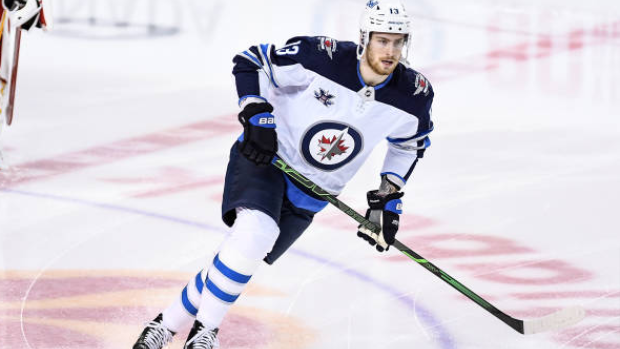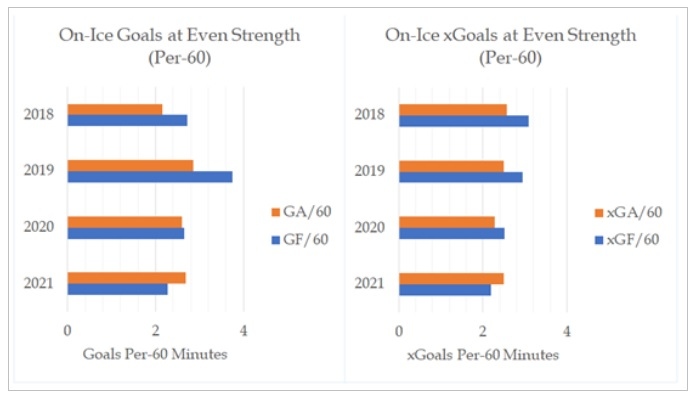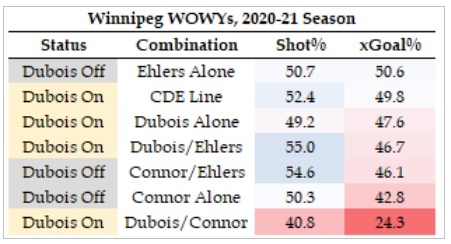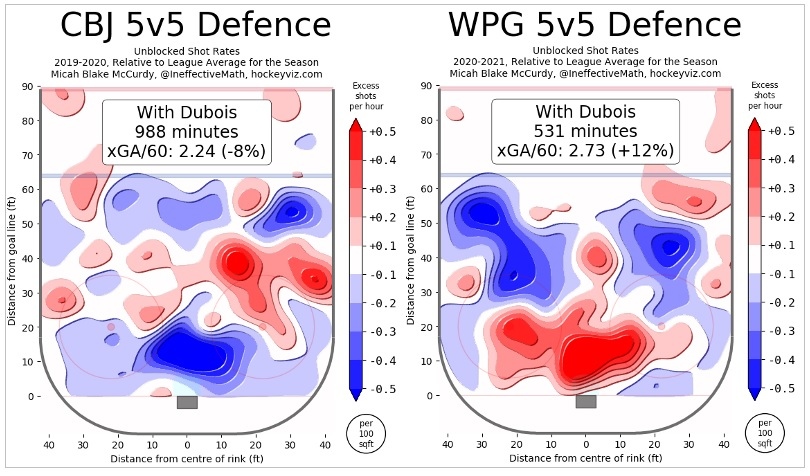Aug 2, 2021
Jets need much more from Dubois in second season
With the Seattle Kraken expansion draft and the opening of unrestricted free agency in the rear-view mirror, Travis Yost begins a seven-part series exploring the most critical questions concerning the Canadian NHL clubs. Up first are the Winnipeg Jets, a team that finished 14th in goal differential (+18) last season.
By Travis Yost

With the Seattle Kraken expansion draft and the opening of unrestricted free agency in the rear-view mirror, we begin a seven-part series exploring the most critical questions concerning the Canadian NHL clubs.
Up first are the Winnipeg Jets, a team that finished 14th in goal differential (+18) last season. The organization is by and large running it back next season – the team did acquire defencemen Nate Schmidt and Brenden Dillon to shore up holes on the blueline, and will need to find another goaltender in lieu of Laurent Brossoit’s departure.
With little roster overhaul, much of the attention will shift towards the team’s core to step up next season. At the top of that list is 23-year-old centre Pierre-Luc Dubois, a restricted-free-agent-to-be whose 2021-22 season could have a dramatic effect on how the Jets and general manager Kevin Cheveldayoff build the roster for the long term.
Dubois was acquired in the middle of January from Columbus in exchange for forwards Patrik Laine and Jack Roslovic. It’s rare we see a deal with that much talent in it, but all three – to varying degrees – were clamouring for a change of scenery.
Dubois, if nothing else, gave the Jets a second threat behind the Mark Scheifele line. A gifted two-way player, Dubois figured to fit into Winnipeg’s system seamlessly.
But that wasn’t the case. Dubois posted career lows in rate shooting and rate scoring, totaling just 20 points (eight goals and 12 assists) in 41 games with Winnipeg. It wasn’t for the lack of talent around him in this case, with promising wing attackers in Nikolaj Ehlers (46 points) and Kyle Connor (50 points) attached to his hip for the majority of even-strength play.
This would be of lesser concern if Dubois’ playmaking was opening up added scoring opportunities for his teammates. But Dubois’ offensive struggles were Winnipeg’s offensive struggles, and the team couldn’t generate much offence with Dubois on the ice for most of the year:

That’s a disconcerting downward trend, but the most important part is last season – a season where the opposition was three goals better than Dubois’ line, and a considerable shift from his days in Columbus.
It’s less clear that Dubois was a true passenger on his own line. The reality is players like Ehlers and Connor also struggled in various combinations. If we look at 2020-21 shot and expected goal differentials for this trio and partial out players accordingly, we see middling to subpar team-level performance across the board.
In fact, the only situation in which a player beat break-even in expected goals was when Ehlers was away from both Connor and Dubois. Or, said another way: when Ehlers was with Scheifele:

These are hardly poor numbers, but Dubois – who has the look and feel of a top-six centre in this league – carries much higher expectations. Breaking even against your competition, or worse yet, being outscored by your competition, is not a great sign when you are a front office considering an expensive long-term contract.
And it’s not just all about defence. Though the true talent levels in Columbus and Winnipeg may be comparable, the teams are polar opposites.
In Winnipeg, Dubois did have access to a number of ultra-skilled offensive forwards and perhaps the best goaltender in the league, offset by a very young blueline and a bottom-six forward group that routinely made defensive-zone miscues. Columbus has trouble scoring most every night, but the Blue Jackets' defensive structure – in good years and bad years alike – has generally held up.
For a while, we suspected Dubois was one of the forwards driving that defensive goodness, aided by strong pairings (like Seth Jones and Zach Werenski). The Blue Jackets routinely had fantastic defensive numbers, and Dubois – a strong backchecker with high off-puck IQ – was excellent at checking forwards in dangerous scoring areas.
Last year saw a reversal of that trend. (via HockeyViz)

If anything has ailed the Jets over the years, it has been breakdowns in the defensive zone – an inability to protect the net, and frequent turnovers of the puck against pressure. To that end, a player like Dubois should be a blessing. He is big enough to check most forwards, intuitive enough to read passing angles as they materialize, and agile enough to skate the puck out of pressure.
It’s tempting to write off the defensive numbers as a Winnipeg issue more than a Dubois one; even writing off the rest of the Jets roster, neither Connor nor Ehlers are strong off the puck, which makes Dubois’ job even more challenging. But if Dubois was brought in to add defensive competency (and I have every reason to believe that was part of the basis of this trade), we didn’t see it in year one.
That is what makes the Dubois gambit so fascinating for Winnipeg. This is an ultra-talented player who had a mystifyingly weak season in Manitoba. Under contract for one more season, the Jets do have a bit of time to evaluate the player and the organizational fit before making a long-term commitment.
For that commitment to happen, I suspect the Jets are going to need to see a lot more from the team’s second-line centre next season.
Data via Natural Stat Trick, Evolving Hockey, HockeyViz, NHL.com

